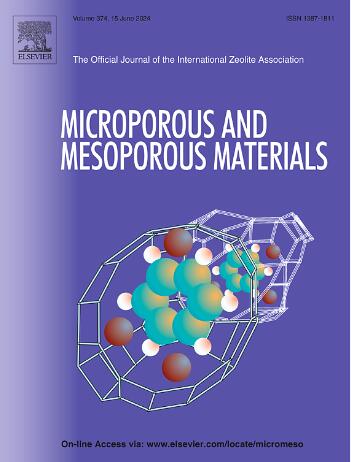Insight into the role of meso-Y zeolites in CsPMo/meso-Y composites on the selective oxidation of sulfides enhancement
IF 4.8
3区 材料科学
Q1 CHEMISTRY, APPLIED
引用次数: 0
Abstract
Polyoxometalates (POMs), renowned for their excellent catalytic activity, are widely used in oxidation reactions. Rational regulation of metal ion valence state of POMs is of great significance for the design and construction of highly active catalyst. In this work, we utilized mesoporous Y zeolite (meso-Y) as a host to load and disperse cesium phosphomolybdate (CsPMo) for selective oxidation of thioethers. The as-prepared CsPMo/meso-Y featured superior catalytic activity and recyclability. The electronic structures of the CsPMo/meso-Y were investigated by XPS and NMR spectra. The results indicated that embedding CsPMo into meso-Y caused electron transfer from CsPMo to meso-Y. Meanwhile, meso-Y could provide H+ due to its abundant Brønsted acid sites. The simultaneous appearance of electron and H+ facilitated the formation of MoV, resulting in a higher oxidation of thioethers activity for the CsPMo/meso-Y. Radical scavenger experiments and Raman analysis indicated that peroxo-metal species derived from CsPMo and oxidizing agent tert-butyl hydroperoxide (TBHP) were the real catalyst. MoV is more conducive to the formation of peroxo-metal species, causing the higher activity. This study provides a new insight into the role of meso-Y in CsPMo/meso-Y and a novel clue to regulate the valence states of metal ions of POMs to enhance catalytic performance of the polyoxometalate based catalysts.

求助全文
约1分钟内获得全文
求助全文
来源期刊

Microporous and Mesoporous Materials
化学-材料科学:综合
CiteScore
10.70
自引率
5.80%
发文量
649
审稿时长
26 days
期刊介绍:
Microporous and Mesoporous Materials covers novel and significant aspects of porous solids classified as either microporous (pore size up to 2 nm) or mesoporous (pore size 2 to 50 nm). The porosity should have a specific impact on the material properties or application. Typical examples are zeolites and zeolite-like materials, pillared materials, clathrasils and clathrates, carbon molecular sieves, ordered mesoporous materials, organic/inorganic porous hybrid materials, or porous metal oxides. Both natural and synthetic porous materials are within the scope of the journal.
Topics which are particularly of interest include:
All aspects of natural microporous and mesoporous solids
The synthesis of crystalline or amorphous porous materials
The physico-chemical characterization of microporous and mesoporous solids, especially spectroscopic and microscopic
The modification of microporous and mesoporous solids, for example by ion exchange or solid-state reactions
All topics related to diffusion of mobile species in the pores of microporous and mesoporous materials
Adsorption (and other separation techniques) using microporous or mesoporous adsorbents
Catalysis by microporous and mesoporous materials
Host/guest interactions
Theoretical chemistry and modelling of host/guest interactions
All topics related to the application of microporous and mesoporous materials in industrial catalysis, separation technology, environmental protection, electrochemistry, membranes, sensors, optical devices, etc.
文献相关原料
公司名称
产品信息
阿拉丁
4-methoxythioanisole
阿拉丁
2-chloroethyl ethyl sulfide
阿拉丁
Methyl phenyl sulfide
阿拉丁
Phosphomolybdic acid hydrate
阿拉丁
Caesium carbonate
 求助内容:
求助内容: 应助结果提醒方式:
应助结果提醒方式:


